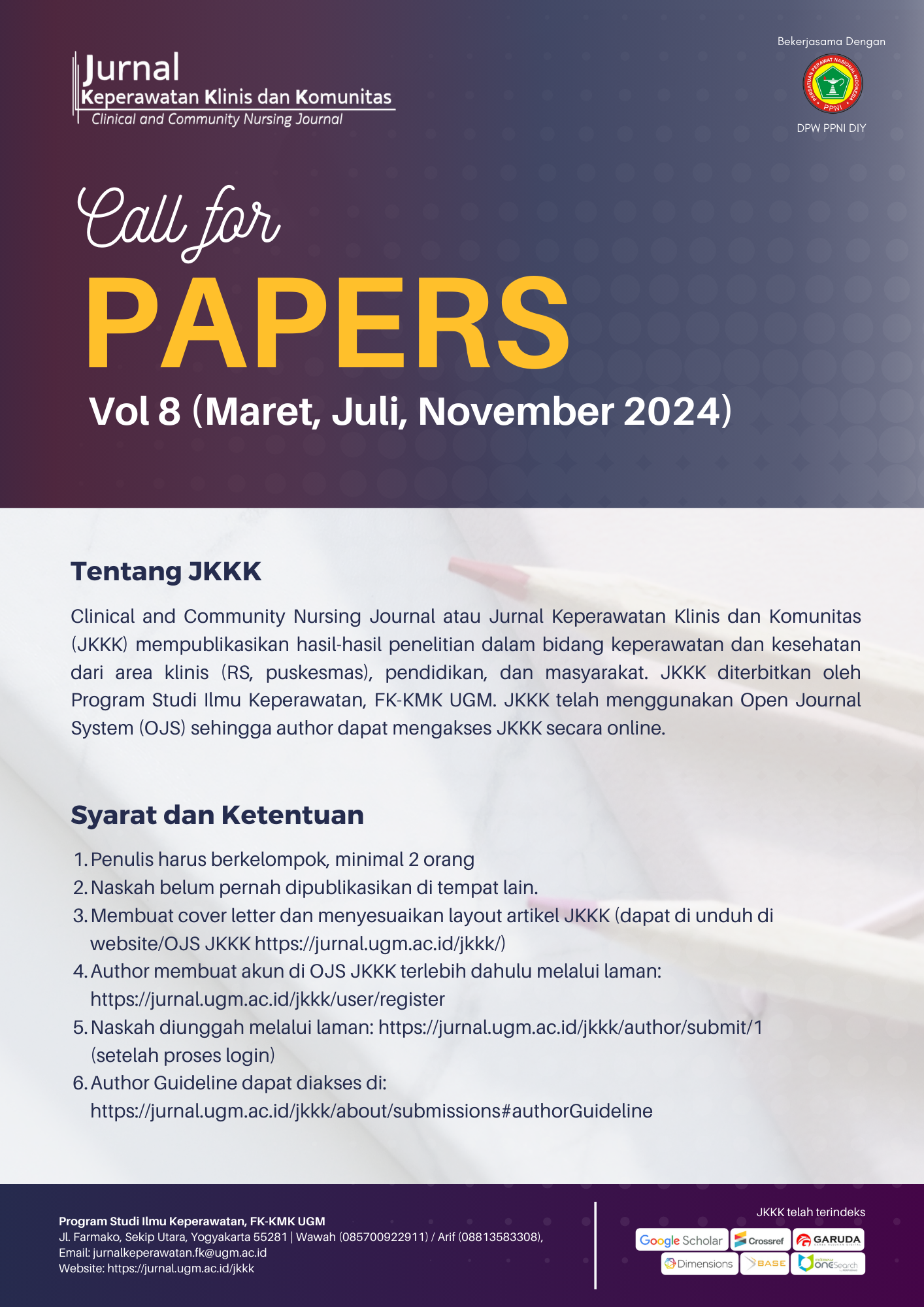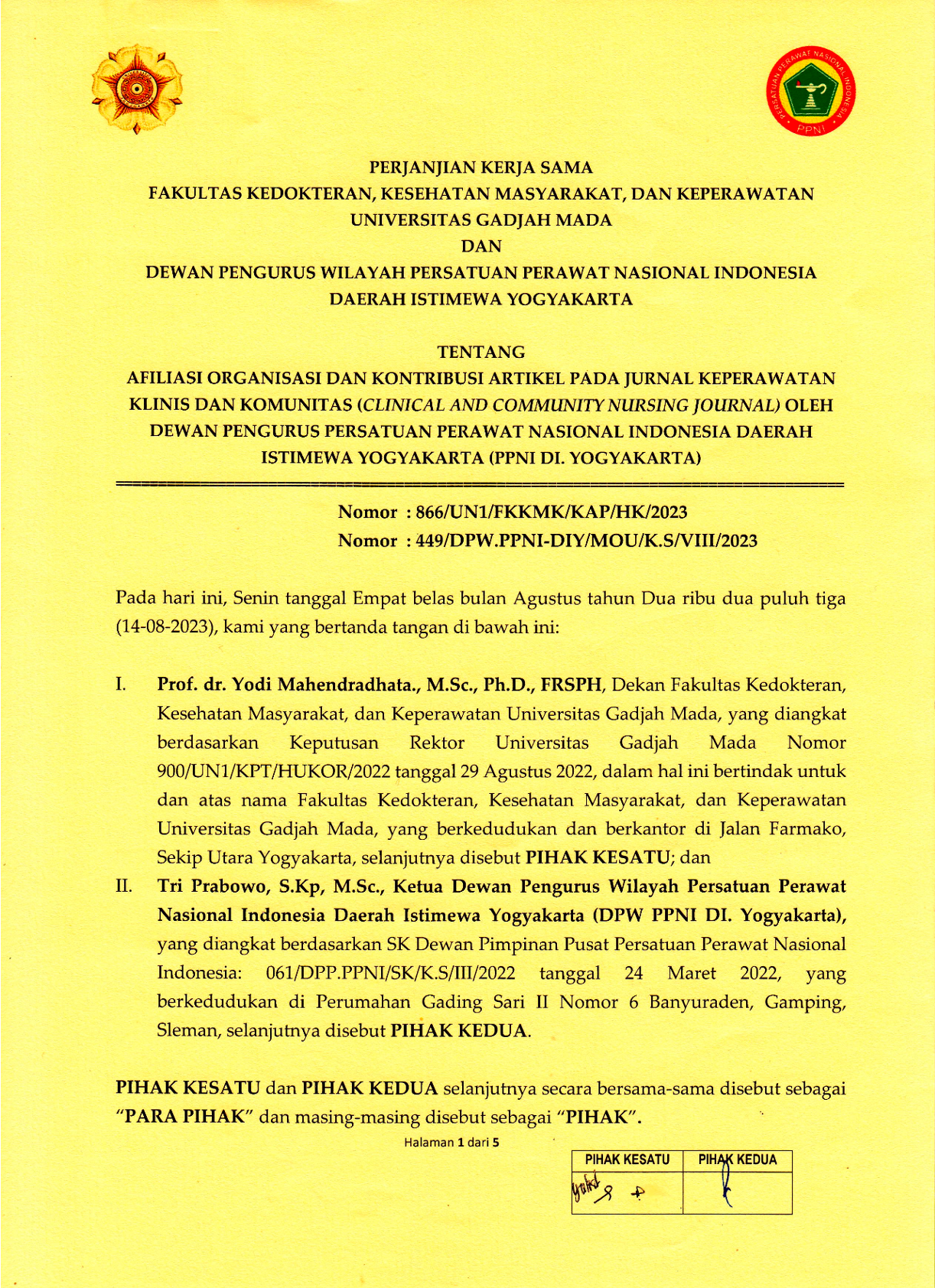Gambaran Kenyamanan Ibu Menyusui yang Menggunakan Ruang Laktasi di Puskesmas Wilayah Kabupaten Sleman
Rizky Endah Wuningsari(1*), Sri Mulyani(2)
(1) Program Studi Ilmu Keperawatan, Fakultas Kedokteran, Kesehatan Masyarakat, dan Keperawatan, Universitas Gadjah Mada
(2) Departemen Keperawatan Jiwa dan Komunitas, Fakultas Kedokteran, Kesehatan Masyarakat, dan Keperawatan, Universitas Gadjah Mada
(*) Corresponding Author
Abstract
Background: The scope of exclusive breastfeeding in Indonesia is still fluctuating, thus the government made policies regarding procurement of lactation rooms in public places and in the workplace. It is necessary for the availability of lactation rooms to consider the comfort of mothers who use it, because comfort is an important condition.
Objective: To understand the description of comfort of breastfeeding mother who used the lactation room in primary health care in Sleman District.
Method: This research was a descriptive quantitative non-experimental research with cross-sectional design. This research was conducted in five Primary Health Care that were selected randomly. The samples of this research were 91 people who had been or currently used spaces in the five lactation rooms at the five Primary Health Cares. Instrument in this study was General Comfort Questionnaire (GCQ) questionnaire from Kolcaba which had been modified. This research was analyzed using univariate analysis.
Result: Physical comfort perceived by respondents including not feeling sore (80,2%), not hungry/thirsty (85,7%), and not tired (91,2%). Psycho-spiritual comfort perceived by respondents including feeling confident (87,9%), satisfied (89,0%), privacy-maintained (87,9%), the mind became calm (90,1%), having no fear (84,6 ), not feeling depressed/discouraged (94,5%), and the need to feel more comfortable when breastfeed in lactation room (93,4%). Environmental comfort perceived by respondents including feeling in a groove (87,9%), comfortable with room lighting (73,6%), no odor (79,1%), the lactation room was easy to find (92,3%), and feeling calm in the room (87,9%). Social comfort perceived by respondents including not feeling lonely (86,8%), not disturbed by people (95,6%), still using the lactation room although there was someone in it (81,3%), and did not require the help of another person when breastfeed in the lactation room (89,0%).
Conclusion: The majority of breastfeeding mothers who used the lactation room felt comfortable in terms of physical, psycho-spiritual, environmental, and social.
ABSTRAK
Latar belakang: Cakupan pemberian ASI eksklusif di Indonesia masih fluktuatif, maka pemerintah membuat kebijakan mengenai pengadaan ruang laktasi di tempat umum maupun di tempat kerja. Adanya ruang laktasi perlu memperhatikan kenyamanan ibu menyusui yang menggunakan ruangan tersebut, karena kenyamanan merupakan suatu kondisi yang penting bagi seorang ibu menyusui.
Tujuan: Mengetahui gambaran kenyamanan ibu menyusui yang menggunakan ruang laktasi di Puskesmas Wilayah Kabupaten Sleman.
Metode: Penelitian ini merupakan penelitian deskriptif kuantitatif dengan rancangan cross-sectional. Penelitian dilaksanakan pada bulan April – Mei 2016 di lima Puskesmas di Kabupaten Sleman. Responden penelitian ini dipilih menggunakan teknik convenience sampling, yaitu sebanyak 91 orang ibu menyusui yang pernah atau sedang menggunakan ruang laktasi di lima Puskesmas tersebut. Alat ukur dalam penelitian ini menggunakan kuesioner General Comfort Questionnaire (GCQ) dari Kolcaba yang dimodifikasi. Analisis penelitian ini menggunakan analisis univariat.
Hasil: Responden merasakan kenyamanan fisik seperti tidak merasa pegal (80,2%), tidak lapar/haus (85,7%), tidak lelah (91,2%), dan merasa sehat (95,6%); kenyamanan psiko-spiritual, seperti merasa percaya diri (87,9%), puas (89,0%), privasi terjaga (87,9%), pikiran menjadi tenang (90,1%), tidak takut (84,6), dan tidak merasa patah semangat (94,5%); kenyamanan lingkungan seperti merasa berada di tempat yang disenangi (87,9%), nyaman dengan pencahayaan (73,6%), tidak bau (79,1%), mudah untuk menemukan ruangan (92,3%), serta merasa tenang (87,9%); dan kenyamanan sosial seperti tidak kesepian (86,8%), tidak ada yang mengganggu (95,6%), tetap menggunakan ruang walaupun ada seseorang di dalamnya (81,3%), dan tidak memerlukan bantuan orang lain ketika menyusui (89,0%).
Kesimpulan: Sebagian besar ibu menyusui yang menggunakan ruang laktasi merasa nyaman baik dari segi fisik, psiko-spiritual, lingkungan, dan sosial.
Keywords
Full Text:
PDFReferences
- Holmberg KSM, Peterson UMC, Oscarsson MG. Sexual & reproductive healthcare a two-decade perspective on mothers’ experiences & feelings related to breastfeeding initiation in Sweden. Sex Reprod Healthcare. 2014; 5(3): 125–30.
- Lowdermilk DL, Perry SE, Cashion K, Alden KR. Maternity& Women’s Health Care. 10th ed. United States of America: Elsevier Inc; 2012.
- Pillitteri A. Maternal & Child Health Nursing: Care of the Childbearing & Childrearing Family. 6th ed. China: Lippincott Williamss & Walkins; 2010.
- Kementerian Kesehatan Republik Indonesia. Profil Kesehatan Indonesia Tahun 2011. Jakarta: Kementerian Kesehatan RI; 2012.
- Kementerian Kesehatan Republik Indonesia. Situasi dan Analisis ASI Eksklusif. Jakarta: Kementerian Kesehatan RI; 2014.
- Kementerian Kesehatan Republik Indonesia. Profil Kesehatan Indonesia Tahun 2013. Jakarta: Kementerian Kesehatan RI; 2014.
- Republik Indonesia. Peraturan Pemerintah Republik Indonesia Nomor 33 Tahun 2012 tentang Pemberian Air Susu Ibu Eksklusif. Jakarta: Sekretariat Negara; 2012.
- Kementerian Kesehatan Republik Indonesia. Peraturan Menteri Kesehatan Republik Indonesia Nomor 15 tahun 2013 tentang Tata Cara Penyediaan Fasilitas Khusus Menyusui dan/atau Memerah Air Susu Ibu. Jakarta: Skretariat Negara; 2013.
- Brown A, Rance J, Warren L. Body image concerns during pregnancy are associated with a shorter breastfeeding duration. Midwifery [Internet]. 2014;31(1):80–9.
- De Jager E, Broadbent J, Fuller-Tyszkiewicz M, Nagle C, McPhie S, Skouteris HA. Longitudinal study of the effect of psychosocial factors on exclusive breastfeeding duration. Midwifery [Internet]. Elsevier. 2015;31(1):103–11.
- Wirihana LA, Barnard A. Women’s perceptions of their healthcare experience when they choose not to breastfeed. Women and Birth [Internet]. 2012;25(3):135–41.
- Isgiyanto A. Teknik Pengambilan Sampel pada Penelitian Non-Eksperimental. 1st Ed. Yogyakarta: Mitra cendekia. 2009
- Mazayani P. Gambaran Kenyamanan Pasien HIV Yang Menggunakan Terapi Antiretroviral di Kota Yogyakarta [Skripsi]. Yogyakarta: Faklutas Kedokteran, Kesehatan Masyarakat, dan Keperawatan, Universitas Gadjah Mada; 2014.
- Budiman, Riyanto A. Kapita Selekta Kuesioner: Pengetahuan dan Sikap dalam Penelitian Kesehatan, 1st ed. Jakarta: Salemba Medika; 2013.
- Wilson L, Kolcaba K. Practical Application of Comfort Theory in the Perianesthesia Setting. J Perianesth Nurs. 2004; 19(3): 164-73.
- Boyer K. Health & Place Affect , corporeality and the limits of belonging : Breastfeeding in public in the contemporary UK $. Health Place [Internet]. 2012; 18(3): 552–60.
- Hinsliff-Smith K, Spencer R, Walsh D. Realities, difficulties, and outcomes for mothers choosing to breastfeed : Primigravid mothers experiences in the early postpartum period (6–8 weeks). Midwifery [Internet]. Elsevier; 2014; 30(1): 14–19.
- Acker M. Breast is best...but not everywhere: Ambivalent sexism and attitudes toward private and public breastfeeding. Sex Roles. 2009; 61(7–8): 476–90.
- Hauck YL, Summers L, White E, Jones C. A qualitative study of Western Australian women’s perceptions of using a Snoezelen room for breastfeeding during their postpartum hospital stay. Int Breastfeed J. 2008;3:20.
- Rice G, Ingram J, Mizan J. Enhancing a primary care environment : a case study of effects on patients and staff in a single general practice. Br J Gen Pract. 2008; 58(552): 465-70.
Article Metrics
Refbacks
- There are currently no refbacks.
Copyright (c) 2020 Rizky Edang Wuningsari, Sri Mulyani

Jurnal Keperawatan Klinis dan Komunitas (Clinical and Community Nursing Journal)
collaborates with DPW PPNI DIY
![]()
Jurnal Keperawatan Klinis dan Komunitas (Clinical and Community Nursing Journal) is licensed under a Creative Commons Attribution-ShareAlike 4.0 International License.





